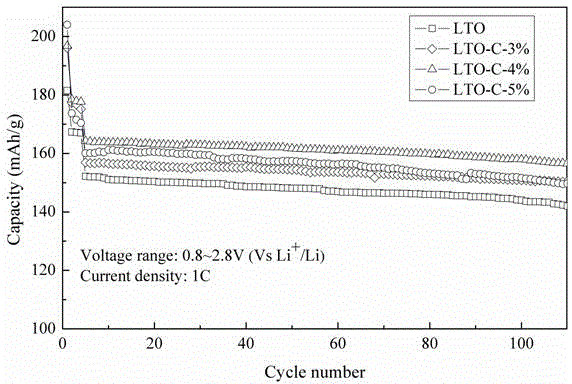Preparation method of carbon-coated sodium-micron-scale lithium titanate composite anode material
A negative electrode material, lithium titanate technology, applied in the direction of nanotechnology, nanotechnology, nanotechnology, etc. for materials and surface science, can solve the problems of increasing lithium titanate production cost, long sintering time, complexity, etc., and achieve improvement Effects of electrochemical performance, high charge and discharge capacity, and uniform particle distribution
- Summary
- Abstract
- Description
- Claims
- Application Information
AI Technical Summary
Problems solved by technology
Method used
Image
Examples
Embodiment 1
[0033] (1) Dissolve 6.17g of lithium acetate dihydrate in an aqueous solution of absolute ethanol at room temperature, stir and ultrasonically dissolve it completely, and record it as solution a;
[0034] (2) Dissolve 20.00g of tetraisopropyl titanate in absolute ethanol at room temperature, stir evenly, and record it as solution b;
[0035] (3) Dissolve 8.87g of industrial oxalic acid in absolute ethanol at room temperature, and ultrasonically disperse to dissolve it completely, which is recorded as solution c;
[0036] (4) First slowly add solution c to solution b, and stir for about 30-40 minutes at the same time to obtain a white sol; then slowly add solution a to the above white sol, and age to obtain a light yellow transparent gel or white gel Glue, the dropping rate is 3ml / min;
[0037] (5) After aging the gel obtained in step (4), place it in a heating mantle, heat and stir at 80°C to obtain a white gel, then place it in a blast drying oven at 80°C for 12 hours, and r...
Embodiment 2
[0047] The difference between this embodiment and Example 1 is the time for pre-sintering and sintering the precursor in step six. The dry gel is fully ground and sieved with 300 mesh to obtain the precursor. The precursor was kept at 600°C for 5.5h at a heating rate of 5°C / min under an argon atmosphere, then raised to 800°C at the same heating rate and kept at 9.5h, cooled to room temperature with the furnace, and ground by 300-mesh sieve to obtain lithium titanate composite negative electrode material. That is 0.86-LTO-1-3.
Embodiment 3
[0049] The difference between this embodiment and Example 1 is that the molar ratio of lithium salt to titanium element used in step 1 is 4.2:5. The specific preparation method is as follows:
[0050] (1) Dissolve 5.04g of lithium acetate dihydrate in an aqueous solution of absolute ethanol at room temperature, stir and ultrasonically dissolve it completely, and record it as solution a;
[0051] (2) Dissolve 20g of tetrabutyl titanate in absolute ethanol at room temperature, stir evenly, and record it as solution b;
[0052] (3) Dissolve 11.29g of citric acid in absolute ethanol at room temperature, and ultrasonically disperse to dissolve it completely, which is recorded as solution c;
[0053] Other steps were the same as in Example 1 to obtain the positive electrode material 0.84-LTO-1-3 in the present invention.
PUM
| Property | Measurement | Unit |
|---|---|---|
| current efficiency | aaaaa | aaaaa |
Abstract
Description
Claims
Application Information
 Login to View More
Login to View More - R&D
- Intellectual Property
- Life Sciences
- Materials
- Tech Scout
- Unparalleled Data Quality
- Higher Quality Content
- 60% Fewer Hallucinations
Browse by: Latest US Patents, China's latest patents, Technical Efficacy Thesaurus, Application Domain, Technology Topic, Popular Technical Reports.
© 2025 PatSnap. All rights reserved.Legal|Privacy policy|Modern Slavery Act Transparency Statement|Sitemap|About US| Contact US: help@patsnap.com



